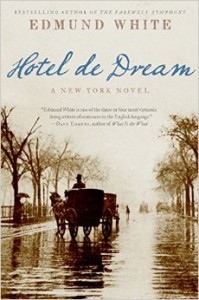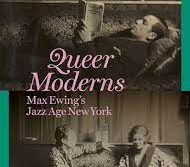 Hotel de Dream: A New York Novel
Hotel de Dream: A New York Novel
by Edmund White
Ecco. 240 pages, $23.95
AUTHOR STEPHEN CRANE is nearing the end of his short life, and his wife Cora is on a fruitless mission to save him by consulting different medical specialists in several countries, to which she travels with their faithful “sad-eyed” dog Spongie in tow. Though Crane is only 28 years old, he realizes that he won’t have much longer to live and worries that he made a grave mistake by destroying the pages of a book he once started about a boy-prostitute in New York City. He recounts how he once met the sickly, painted boy named Elliot in the streets and tried to help him, then spent time observing him and the behavior of his underground circle of transvestites and homosexuals. During a journey to Germany in a nearly unconscious state of mind, Crane painfully dictates to Cora a new book based on the boy-prostitute Elliot. It primarily focuses on his love affair with a middle-aged banker named Theodore and the older man’s sexual obsession with the effeminate teenage boy. As if this weren’t scandalous enough, Crane writes about the affair and about Theodore with a startling degree of compassion and sympathy. Though he’s nearly deranged with passion for the slight, violet-eyed boy, Crane also discovers something beautifully noble in Theodore’s loyalty and tremendous love.
Could it have been possible that a straight young writer at the turn of the century would write about such scandalous characters? This book is entirely a “fantasia” created by Edmund White, inspired by a few unreliable accounts of Crane and an alleged work-in-progress that might have ruined his writing career if it hadn’t been destroyed by other means. The shady or incomplete history of Crane’s life—there is currently no definitive, reliable biography—allows White ample room to conjure deeply human stories about the author and the fiction he might have written. The novel within the novel that Crane is shown dictating is entirely in keeping with his vast sympathy for people who exist on the fringes of society. Crane’s fiction and journalism reveal an ability to recognize the common humanity that runs through people from all the different corners of life. It’s entirely plausible that Crane would take hints from the boy’s own life story and create his own version of it as a tale of a timeless, tragic love affair. White is careful not to write about Crane as if he were a saint. He is disturbed, nearly sickened, when he encounters the strange little transvestite prostitute. But the author’s curiosity and sympathy for the downtrodden draw him to investigate and understand Elliot’s world and his thoughts about it. The novel features a colorful cast of characters, notably the brazen, catty transvestites who teach the boy-prostitute an impressively inventive queer vocabulary. For example, “fellatio was ‘to blow the skin flute’ … If a fairy turned to women and a normal life, it was said that he had ‘lost his gender.’ Mutual masturbation was ‘chopsticks.’” The novel also includes a few recognizable literary figures known and befriended by the real Stephen Crane, such as a charming, vividly described Joseph Conrad and a daunting but hilarious Henry James, who turns out to be a pivotal character in the book. It’s appropriate that the book is subtitled “A New York Novel.” The environment of the city is evoked in such breathtaking language and with such flourishes of detail that it becomes a character in itself. “The weak sunlight was filtering down through the rail slats of the overhead elevated tracks, and every few minutes another train rumbled slowly past above our heads like a heavy hand on the keyboard.” The amount of research the author must have done to recreate a time and place from over a century ago is impressive, providing a believable backdrop into which White’s entertaining story has been seamlessly woven. Hotel de Dream is the name of the brothel that Cora used to work at, but it also describes the dying Crane’s near-hallucinatory state of mind as he desperately tries to record the story of the troubled boy-prostitute. Throughout his career, White has shown a fascination with the lost stories of people when they meet their inevitable end. As in his previous historical novel Fanny: A Fiction (2003), this novel seeks to capture a book that may have been smothered by circumstance before it was allowed to be fully committed to paper. White has been profoundly influenced by the dictum that when an educated person dies, a library burns. Here his Proustian desire to invoke and recreate the past, then re-imagine it with the emotionally charged sentiments that frame it as a fictional tale, turns this novel into a kind of literary archaeology. It sheds light upon a queer community that necessarily lived in the shadows and that has gone largely unacknowledged until recently. There are important stories buried between the lines of mainstream history books, and White has imaginatively excavated one such story, and done so with wit, gusto, and ingenuity. ____________________________________________________________________ Eric Karl Anderson, who is the book reviews editor for the queer arts journal Chroma, is the author of the novel Enough (2004).





